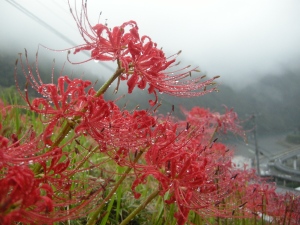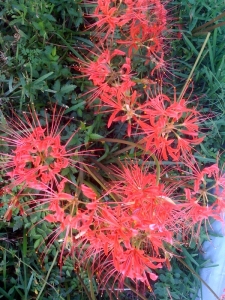A young friend of ours is currently doing one of the coolest things that I can imagine a tall, blonde, 22-year-old American ever doing after graduating from college. She is teaching English to Japanese elementary students in remote, rural Japanese village named Totsukawa. While she is away, she is keeping a blog so all of us who are stuck in our mundane, state side lives can live vicariously through her. She is an excellent writer. When I was reading her latest post, I came upon a little gem that really caught my eye: “Spider lilies are called “higanbana” in Japanese. According to Buddhist beliefs there is a river that separates the world of the living and the world of the dead, and higanbana grow on the opposite bank to guide the spirits across the river.” Now how cool is that? Spider lilies leading the way to Buddhist heaven. This pleases me greatly since spider lilies are probably my favorite bulb. I don’t know if I will go to Buddhist heaven (or Christian heaven for that matter), but if I do get to go I really like the thought of spider lilies leading the way!
My spider lilies (Lycoris radiata) were a gift from the previous homeowner. The first fall that we were there, we noticed these odd, single stems beginning to shot up in our front yard. We had no idea what they were but we decided to mow around them and see what they would become. Well we were pleasantly surprised when the flowers burst open! I instantly fell in love with these bright red, exotic looking beauties. When I found out that one of their common names is “Naked Ladies”, I decided I loved them even more!
Until I read her post, I did not realize that spider lilies are native to Japan. These rather unique looking bulbs rise up out of the ground on a single stalk and produce a single, red flower. They usually bloom here in late September or early October. Thanks to the graceless gaijin, I now know that they bloom at the same time in their native Japan.
Spider lilies have a relatively short bloom time, generally two weeks or less. When they are in bloom you can extend their life by providing adequate water. Once the flower dies, the foliage appears a couple of weeks later. The foliage is a dark green clump that is reminiscent of lariope. This clump will last until spring.
Luckily for us, these bulbs naturalize very readily in Texas. If you buy bulbs (The Southern Bulb Co. is a great place to look: http://www.southernbulbs.com/catalog/index.php), you can plant them in full sun or partial shade. The bulbs should be buried to a depth of three or four inches in good soil that has been amended with lots of organic material. Provide normal water through the spring and summer and then wait for the fall show. Since they naturalize so readily, you can also divide the bulbs you already have. It is best to do this in the spring after foliage has died back.
Since the blooms and the foliage of the spider lilies eventually all die and disappear, I always seem to forget they are there. Each fall, the appearance of those single “naked” stalks always lifts my spirits and informs me that once again, it is time to slow down and pay attention to what nature is about to share with me. I don’t know if Spider lilies will line the path to my heaven, but I certainly hope they do!


